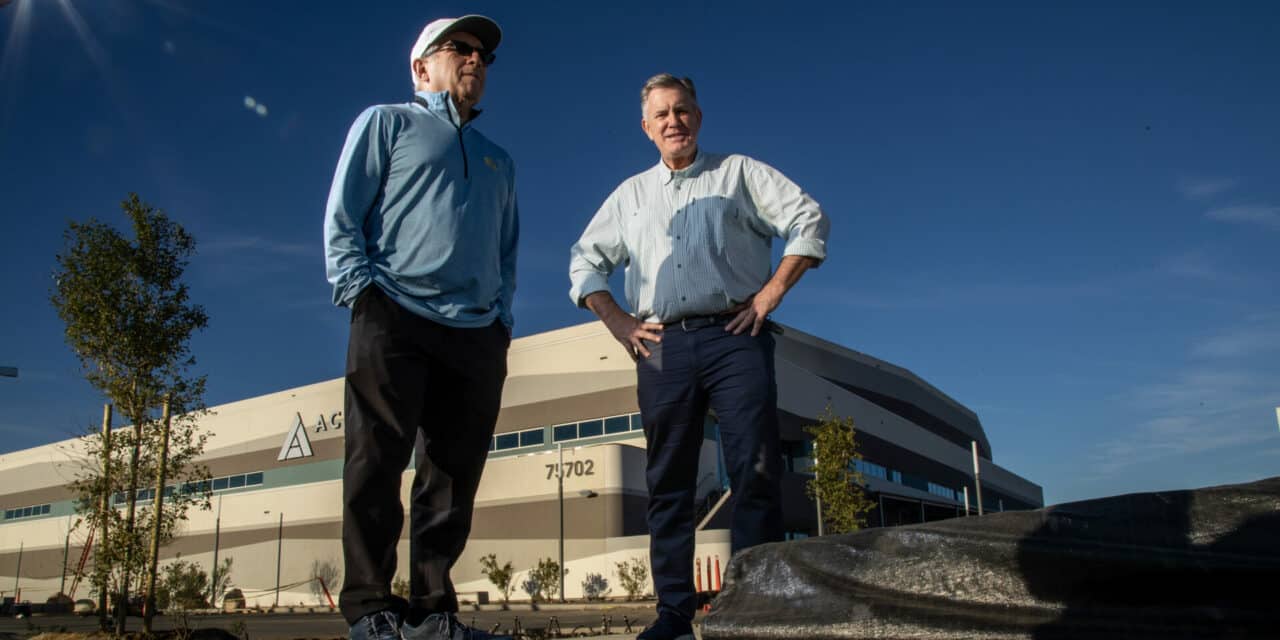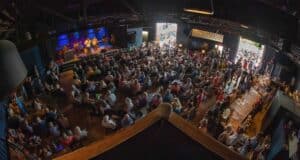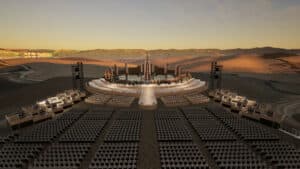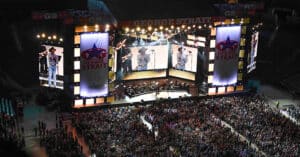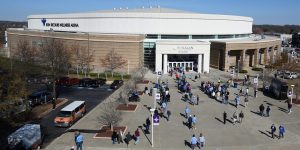DESERT DENIZENS: Oak View Group co-Founders Irving Azoff, left, and Tim Leiweke, the burgeoning company’s CEO, stand outside Acrisure Arena in Thousand Palms, California, in the greater Palm Springs area. (Getty Images)
Acrisure Arena opening near Palm Springs caps busy year for Oak View Group
Acrisure Arena, a linchpin for expanding live music in Greater Palm Springs and the home of the AHL’s new Coachella Valley Firebirds, was poised for its debut as John Bolton, the building’s general manager, led a recent hardhat tour through the facility.
The $300 million arena was privately funded by OVG, Live Nation and the NHL Seattle Kraken, the Firebirds’ parent team. Comedians Dave Chappelle and Chris Rock were booked to christen the facility on Dec. 14, followed by the Doobie Brothers the next night.
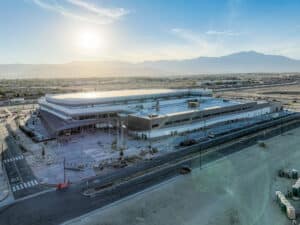
VALLEY VIEW: Set amid the scenic Coachella Valley near Palm Springs, Acrisure Arena went from groundbreaking to opening in about 18 months. (Courtesy OVG)
Capacity runs about 11,000 for a building expected to book major tours in a desert resort market that’s a two-hour drive southeast of Los Angeles. The arena features touches of indoor/outdoor aspects common among Southern California venues, but with elements that speak to the desert climate.
“Everything’s in the lower bowl in terms of seating,” Bolton said, stepping inside the venue managed by OVG360. “You enter at ground level then go down to
the seats. The only thing upstairs are 770 club seats and 20 suites.”
Construction crews dug 25 feet below the surface to where the main ice sheet sits. The practice rink also sits below grade about 12.5 feet, giving both ice sheets the advantage of cooler temperatures than at the surface in the desert, where temperatures can reach 120 degrees.
“We didn’t want to obstruct any mountain views,” Bolton said. “That was the purpose of digging down instead of going up.”
The building is no more than 60 feet above grade at its highest point, as opposed to 100 feet at a typical arena. “The design complements the natural environment,” Bolton said of the building’s low profile, which creates less wind resistance.
There are elevators, but no escalators, to reach the premium level upstairs, which is just 15 feet above the main concourse, said lead designer Robert Norvell, principal and senior architect at Populous. The premium level serves fewer than 2,000 patrons, Norvell said.
One distinction in the seating bowl: there is no center-hung videoboard, which is a trend among new midsize arenas. OVG instead opted for a Daktronics flat screen installed in the west end and a ribbon board that rings the lower bowl.
“It makes it easier for the show rigging,” Bolton said. “For us, it was about being able to hang 400,000 pounds from the roof and not have interference with a center-hung. For people, when you look at a scoreboard, you’re seeing about a third of it, depending on where you are, and you’re always looking up. Here, you really get better quality than what you’d see in a traditional scoreboard, three times the amount of viewing.”
There’s an outdoor artist and crew compound on the west side adjacent to the green rooms, plus a catering kitchen and dining area, that extends to lounge seating, shade/shelter, a firepit, bocce ball and a 9-hole putt-putt course, all with a view of the San Bernardino and San Jacinto mountain ranges.
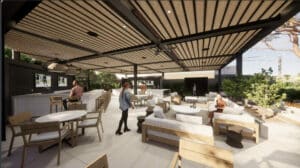
COMPOUND INTEREST: A rendering shows the artists’ compound that’s soon to open at Acrisure Arena near Palm Springs. (Courtesy OVG)
“We think it sets us apart from other arenas nationwide,” Bolton said of the compound, with plans to open it in the first quarter of 2023. “We’re trying to take advantage of the beautiful landscape that’s all around us and, for most of the year, pretty nice weather, though not in August.”
Five loading bays provide easy access for trucks in a marshaling area with additional space for tour buses.
The main entrance on the east side is designed to protect guests from the funneled desert winds, Norvell said. A canopied outdoor concessions plaza within the ticketed space will be populated by five vendors serving from food “pods.”
“That’s unique, for a hockey venue to have an exterior concourse to take advantage of the climate here,” Norvell said.
“The amenities on this side are on the outside of the bowl versus on the inside,” said Phillip Ransford, Acrisure Arena’s vice president of operations. “It’s really kind of grab-and-go after they cook it.”
The Berger Foundation Iceplex, the Firebirds’ practice facility, is attached to the arena. It’s named for the local H.N. and Frances C. Berger Foundation. It will be open year-round for community skating, leagues and lessons.
The Firebirds’ merchandise is flying off the shelves of a team store in a nearby shopping center that showcases a model of Acrisure Arena, Bolton said.
The Palm Springs region has a large contingent of snowbirds and transplants from Canada and northern U.S. states where hockey is popular, and Bolton expects that to weigh heavily in the Firebirds’ favor. The team’s home debut is Dec. 18.
Palm Springs International Airport, 12 miles southeast of the arena, has six daily non-stop flights to Seattle with sponsor Alaska Airlines and serves other key feeder markets such as Portland, Oregon, San Francisco and San Jose, California, with connections to scores of other locations.
“Seattle is one of our top fly-in markets,” Bolton said. “A lot of people have second homes here and the Canadian influence here, I can’t underestimate how big that is, and they’re all huge hockey fans.”
Acrisure Arena has three electric Zambonis, one for the practice rink, with two dozen sustainability features, Norvell said.
Electrical lines and other infrastructure lie beneath a surface parking lot that can accommodate 3,000 vehicles, with solar arrays that should generate enough electricity to power the arena on non-event days, Ransford said.
The arena sits on a 400-acre parcel as part of a future mixed-use development of retail, office, a hotel and residential units, Bolton said. The site is adjacent to the Classic Club, home of the PGA Tour’s American Express Desert Classic golf tournament, formerly the Bob Hope Desert Classic.
“Hopefully I’ll look out there one day and there will be a nice, huge hotel,” he said.
The arena is two miles from the San Andreas Fault, which required additional engineering for earthquake resistance. It also requires an exit plan and signage, plus training staff to handle a potential seismic event, Norvell said.
Norvell said the arena was originally contemplated for downtown Palm Springs, right off the main strip, and it ended up 15 miles closer to the fault, increasing potential seismic forces by 20% to 50% compared to the original site.
In addition, the site is part of a 100-year flood plain, which required a plan to divert water from the golf course, he said.
“COVID hit, things happened, and we moved sites,” Norvell said. “Luckily, we found a good partner in the Berger association. They had this site ready to go. There was a 2006 environmental impact study done on this piece of land. They had done some rough grading, so it wasn’t technically a green field. The environmental study went quicker.”
The 18-month timeline from groundbreaking to grand opening came during the pandemic, which Bolton attributes to being 100% design ready.
“As COVID was shutting things down, it was full speed ahead,” he said.
CAA Icon is the owner’s representative on the project while AECOM Hunt is the general contractor.
Norvell said the client’s marching orders called for “a flagship music venue for the Coachella Valley” that would also be optimal for AHL hockey.
“Coachella Valley has such a historic music presence without having a venue that matched its history,” he said. “One of the thoughts from OVG was that this could be the starting place for big acts to get their show figured out before doing West Coast tours and hitting bigger markets. It was a music-first outlook for the arena, while also creating a state-of-the-art AHL facility.”
OVG Hospitality is handling the food and beverage operations at the arena, which is cashless. A grab-and-go market will allow fans to quickly get back to the action. Arena bars are situated across the west end of the bowl. Milagro Tequila sponsors one bar, Garrison Brothers Bourbon the other. Founding partner Buzzbox is the arena’s exclusive ready-to-drink beverage supplier. Both bars have views to the event floor.
One month before opening, the 770 club seats and all but two of the 20 suites have been sold. Most club seats are situated in the East and West Lofts and have access to outdoor patios. The Chairman’s Club, with room for about 250, is situated off the concourse. Two Founders Lounges are in addition to the 20 suites, which each fit 20.
“It’s like owning a suite without owning one,” Ransford said. “You can buy two individual seats for the lounge, and it comes with the bar and the food. It’s like a club suite.”
Staffing has gone surprisingly well, Ransford said.
“The numbers that we’re pulling for crews is astounding,” he said.
“We did nine job fairs, one in each city throughout the Valley,” added Bolton. “We needed to hire over 1,000 people. We had a huge response and all of our positions and most of our third-party vendors are fully staffed. There are a lot of retired people and this is a cool part-time opportunity, especially for the ones who love hockey and music.”
